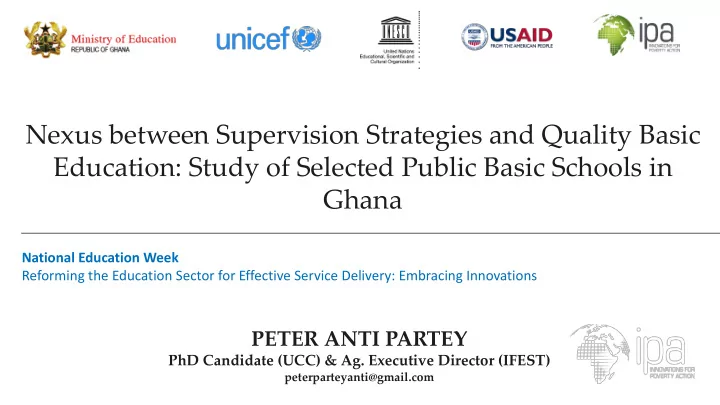

Nexus between Supervision Strategies and Quality Basic Education: Study of Selected Public Basic Schools in Ghana National Education Week Subtitle placeholder Reforming the Education Sector for Effective Service Delivery: Embracing Innovations PETER ANTI PARTEY PhD Candidate (UCC) & Ag. Executive Director (IFEST) peterparteyanti@gmail.com
Outline of Presentation v Context v Conceptual Framework v Research Hypotheses v Methods v Key Findings v Conclusion v Policy Implications
Context QUALITY BASIC EDUCATION (QBE) • Quality of Infrastructure • School Environment School Factors • Class Size • Curriculum NATIONAL EDUCATION • Family Background SUPERVISION & Student Factors • Gender, Age, etc MONITORING SYSTEM • Academic qualification • Teaching Experience Teacher Factors • Choice of Pedagogy
Conceptual Framework National Inspectorate Board Figure 1: Diagram showing the hypothesized relationship between Supervision and Monitoring and Quality Basic Education Source: Author’s Construct (2019)
Research Hypotheses v Based on the conceptual framework developed for the study, the following hypotheses guided the study: v H 0 : There is no statistical significant relationship between Monitoring and Supervision of teaching and learning and quality basic education . H 1 : There is a significant relationship between Monitoring and Supervision of teaching and learning and quality basic education. v H 0 : There is no statistical significant influence of type of supervisory strategy on the quality of basic education . H 1 : There is a statistical significant influence of type of supervisory strategy on the quality of basic education.
Methods v Quantitative Approach v Ex-Post Facto or Causal Comparative v Population was all Public Basic Schools in the Central and Ashanti regions of Ghana (Teachers and Pupils) v Two Research Instruments Questionnaire for Teachers (Measure Supervision strategies) v Standardized Test Items for the Pupils (Mathematic and English language)(Measure QBE) v v Data Analysis was carried out using SPSS v. 22. Both descriptive statistics (Frequencies and Percentage) and Inferential Statistics (Pearson correlation and Logistic regression)
Methods cont. Sample and Sampling Techniques 6 Teachers for each Multistage Sampling Stratified Simple Random school 2 Public Basic 30 Basic 7 Schools Pupils from Rural 15 districts each each Sub-Urban (5 from each) Ashanti Region (30) school Urban = Rural 360 Central Region 15 districts 2 Public Sub-Urban Teachers (5 from each) Basic Urban Schools 1800 Pupils each (30)
Wide variation in students’ performance in Math and English Performance in Mathematics Performance in English Language 350 320 295 300 272 4% 8% 6% 240 11% 250 100-75 225 12% FREQUENCY 74-70 69-65 200 17% 64-60 15% 156 59-55 150 54-50 125 15% 49-45 12% 44-40 100 85 82 39-0 50 0 100-75 74-70 69-65 64-60 59-55 MARKS N = 1800 54-50 49-45 44-40 39-0
RELATIONSHIP BETWEEN SUPERVISION AND QUALITY EDUCATION Strong positive SUPERVISION AND MONITORING relationship between Monitoring and Supervision and Quality Basic Education QUALITY BASIC EDUCATION
Influence of Supervisory Strategies on Quality Basic Education 6 Ø Strong positive effect of democratic supervisory strategy 5.3 5 on quality basic education 4 3.7 3.3 Ø Negative effect of autocratic 3 supervisory strategy on quality 2 basic education 1 Ø Note that other variables were 0 -0.3 controlled by the model. Laissez-faire Inspection Democratic Autocratic -1
Democratic vs. Autocratic supervisory strategies The supervisor believes there is The supervisor and the only one way of delivering teacher together decide on the instruction and that is the most best approach to improve the effective and efficient way and expects teachers to do exactly that teaching/learning situation
Conclusion v The openness, collaboration and involvement of teachers as a strategy adopted by supervisors affect the effectiveness of supervision and monitoring leading to improvement in instructional delivery. v This, therefore, appeal to teachers positively because they become part of the supervision exercise. v It can be concluded that, supervisors who “ partner” teachers during instructional delivery are perceived to improve teaching and learning than supervisors who “police” teachers during lesson delivery.
Policy Implications v Repositioning and Resourcing the NIB by the Ministry of Education to enable them carry their mandate fully. v Training processes for supervisors by the NIB should surround current practices and trends in school and instructional supervision. v Recruitment of supervisors should be targeted, well structured and managed to enable NIB get the best for supervision assignments v The Ministry of Education should foster collaboration between NIB and other agencies like NaCCA, NAB, and GES and organize quarterly interaction meetings between these agencies to compare notes v More focus should also be on internal supervision, peer review and teacher collegiality and Head teachers should be equipped to deliver this mandate ( Innovative supervision ).
Thank you
Recommend
More recommend